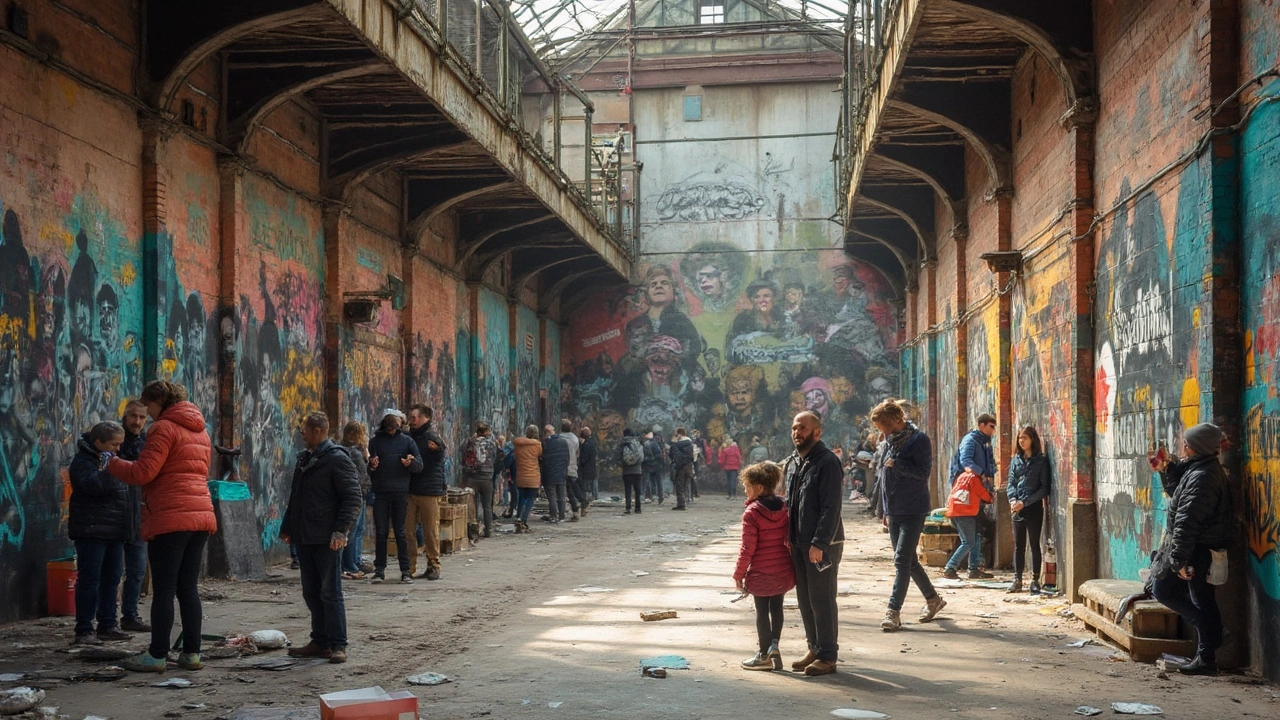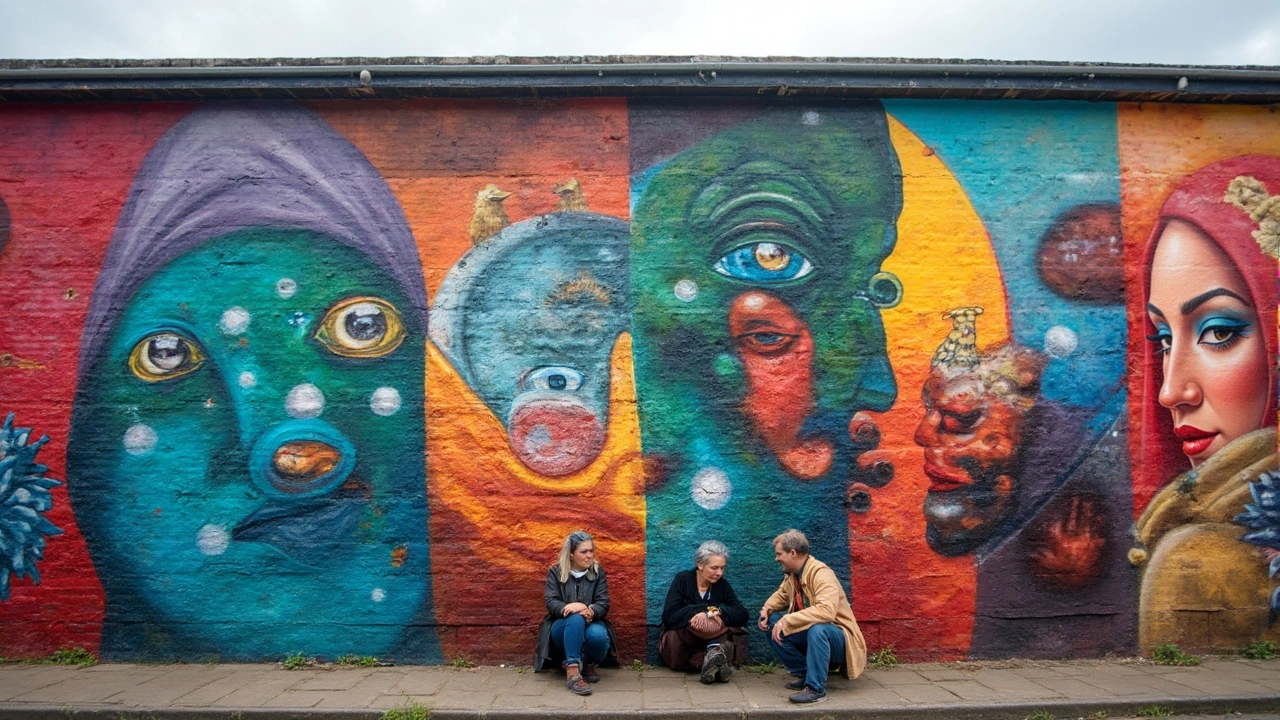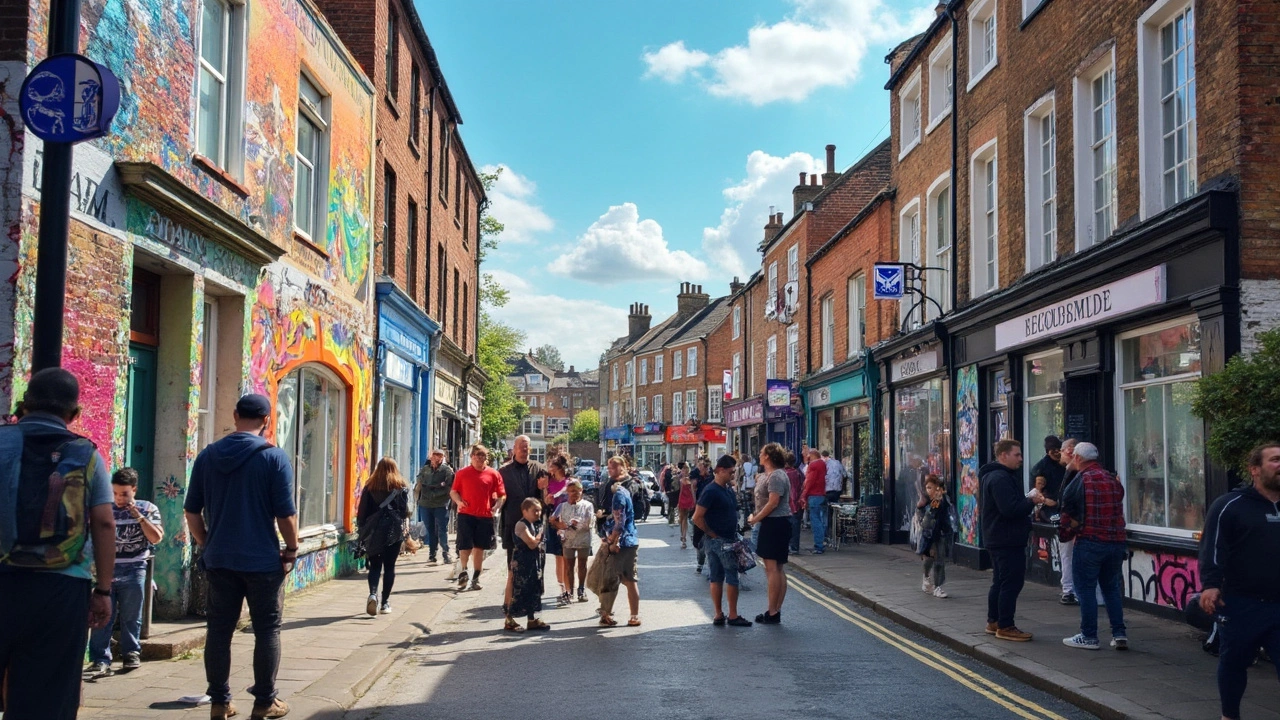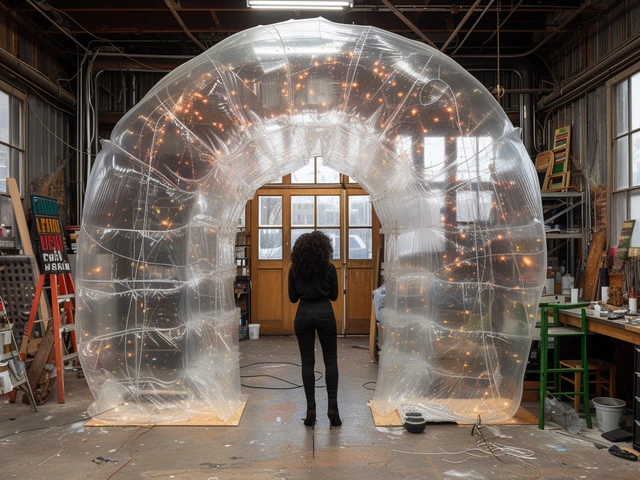Street art isn't just about creating vibrant splashes of color on dull walls. It's a way people connect, share stories, and transform the spaces they call home. Look at any bustling city, and you'll see how street art is breathing new life into neighborhoods. It's not just for show; it's community building in action.
Take a walk in many city streets, and you'll stumble upon murals that speak volumes about local history or current issues. These artworks are often created by artists who either belong to the community or are so invested that they become honorary members. It's their canvas but also a powerful form of communication. Anyone can relate to a mural that touches on cultural themes or social justice.
Want to know how to turn your own corner of the world into something more meaningful with street art? It starts with understanding the community’s spirit. Successful projects widely involve local voices from the start, ensuring the art resonates with the people who live there. Walk through any transformed alley or lively building façade, and you'll feel a sense of belonging. This is street art's magic — creating connections that surface in the most surprising places.
- The Evolution of Street Art and Its Community Impact
- Street Art as a Tool for Social Change
- Murals: Bringing Color and Unity to Neighborhoods
- Success Stories of Street Art in Urban Development
- How Communities Can Embrace Street Art
The Evolution of Street Art and Its Community Impact
Street art has come a long way from being labeled as mere vandalism. Today, it is a respected form of art and communication, giving a voice to the voiceless and reshaping urban landscapes worldwide. From vibrant murals to thought-provoking graffiti, street art has become a key player in the cultural and social development of communities.
Back in the 1970s, New York City's subway cars were the original canvas for what we know now as graffiti. These early pieces were often dismissed as public nuisances. However, as the art form developed, it moved beyond mere tagging to intricate and artistic expressions that began to capture public interest. This evolution played a big role in shifting perceptions, turning street art into a medium for storytelling and social commentary.
Fast forward to today, and you'll see how these artworks are more than just paint on walls. They're catalysts for change, sparking conversations on issues that affect communities. Think of striking murals advocating for social and political causes, or those that honor cultural heritage. Such pieces can dramatically impact how communities identify and represent themselves.
Murals and other types of street art have transformed neglected urban areas into bustling hubs of creativity and interaction. For example, the Wynwood Walls project in Miami turned a drab industrial neighborhood into a lively open-air art walk attracting visitors worldwide. These kinds of transformations carry significant economic implications too. Businesses thrive as foot traffic increases — a win-win for locals and tourists!
| City | Annual Visitors Due to Street Art | Economic Boost % |
|---|---|---|
| Miami | 1.5 million | 25% |
| Melbourne | 300,000 | 15% |
The impact of community-focused street art is undeniable. It builds pride and encourages collaboration among neighbors. When people see their culture and concerns reflected in art, they feel valued. They have a stake in their community's appearance and reputation. Ultimately, this fosters a sense of ownership and unity that simple beautification can't achieve on its own.
So, the next time you walk past a vividly painted wall, remember it’s more than just an eye-catching sight. It’s a reminder of how far street art has come and its powerful role in bringing people together.
Street Art as a Tool for Social Change
Street art isn't just eye candy; it's a loudspeaker for social change. All around the world, artists use their work as a voice for the voiceless, bringing attention to critical issues like inequality, politics, and cultural identity. It's not uncommon to stroll past a mural that makes you stop and think, 'Wow, that really speaks to what's going on today.'
Consider the powerful murals in neighborhoods like the Mission District of San Francisco, where street art covers walls with stories of immigration, resistance, and community struggles. These works often spotlight experiences that don't get a lot of air time in mainstream conversations, offering a unique platform for expression and solidarity.
Across the globe, you'll find street art movements driving social change. Take, for instance, the famous murals in Belfast, Northern Ireland, which depict the turbulent history of The Troubles. These art pieces serve as a living history lesson, reminding people of past conflicts while advocating for peace and reconciliation.
Street art also thrives in places you might not expect. During the COVID-19 pandemic, artists took to the streets to provide not just commentary, but inspiration and hope, especially in hard-hit communities. Everywhere you look, street art was spreading messages about health, safety, and community resilience.
With such deep roots, it's no wonder that street art can heavily influence social movements. When communities embrace street art, they don't just pretty up their neighborhoods; they celebrate diversity, champions change, and even economically uplift their areas by attracting tourism and investment. This ripple effect shows how powerful a painted wall can really be!

Murals: Bringing Color and Unity to Neighborhoods
Murals are like the soul of a neighborhood splashed across walls. When you think about street art, massive and colorful murals often come to mind. But they're more than just eye candy; they’re tools that bring people together in surprising ways.
Take Philadelphia's 'Mural Mile' as an example. This city, with its rich history, has used murals to celebrate both its cultural diversity and city pride. Created in collaboration with locals, these artworks not only beautify spaces but also tell stories of the community's past and hopes for the future. This process creates a sense of ownership that can be incredibly powerful.
Don't forget about Miami's Wynwood Walls. Once just a collection of drab warehouse buildings, this area is now an internationally recognized hotbed for urban culture thanks to its vibrant murals. Tourists and locals alike flock there, snapping photos and soaking in the energy. Wynwood shows how a simple idea can turn an ordinary space into a must-see destination.
So, how do murals foster community? By engaging people in the creative process! Artists often work with neighborhood associations or local governments. This involvement ensures the mural reflects the community's voice and values.
For neighborhoods looking to enliven their streets, organizing mural projects can be a straightforward process:
- Start by gathering a group of interested residents or local artists.
- Secure permissions if certain walls are privately owned. Some cities have grants to support public art.
- Get creative—develop themes or symbols that resonate with the community.
- Finally, pitch in and paint! These projects often double as fun community events.
These murals don’t just paint walls; they color relationships and tie people together with pride. When locals see a piece of art that they helped bring to life, it creates a shared identity and a stronger community bond.
Success Stories of Street Art in Urban Development
Street art has done wonders in turning forgotten urban spaces into lively, bustling parts of town. One standout example is the Wynwood Walls in Miami. Once a neglected warehouse district, it's now a global destination for street art lovers. Through a combination of artistic vision and community involvement, local developers transformed Wynwood into an open-air gallery that attracts tourists, artists, and new businesses.
In another incredible transformation, Philadelphia's Mural Arts Program has been a game-changer. This city initiative has not only beautified the urban landscape with over 4,000 murals but also engaged with local communities to address social issues. They've partnered with schools, prisons, and rehabilitation centers to use street art as a means of education and healing. This has empowered residents and fostered a strong sense of identity and belonging.
Moving to South America, the Medellín Commune 13 in Colombia is a powerful testament to the impact of murals and graffiti in urban revitalization. This area, once known for its violent past, now tells a different story. Artists collaborated with residents to cover the neighborhood in vibrant murals, depicting hope and resilience. This has not only shifted perspectives but also boosted tourism and local pride.
When it comes to successful street art transformations, the key often lies in collaboration and understanding community needs. Actions like including residents in the process and aligning art projects with local values have made a significant difference. These success stories highlight that street art isn't just pretty pictures on walls - it's a powerful tool for urban renewal and communal harmony.

How Communities Can Embrace Street Art
Thinking about bringing a splash of creativity to your neighborhood through street art? It's not just about grabbing some paint and finding a wall. It's a community effort that requires planning and collaboration.
First off, get the locals involved. A successful street art project reflects the community's character and values. Put out a call for ideas and invite everyone to share what they'd love to see. Whether it's a mural celebrating local heroes or colorful designs brightening up a playground, the key is making sure the art resonates with the people living there.
Partnerships are golden. Team up with local artists, schools, and organizations. Artists bring expertise and creative flair, schools can educate students about art's role in society, and organizations may offer funding or other support. You'll be amazed at how fast things come together when everyone chips in.
Now, let’s talk logistics. Consider organizing workshops or events where neighbors can paint alongside artists. This hands-on involvement creates a sense of ownership and pride. Plus, it's a great way for strangers to become friends!
Publicize the effort. Sharing the transformation on social media platforms can draw attention and possibly more support. It creates a buzz and even attracts visitors interested in seeing how urban culture is thriving in your area.
Don't forget to maintain the artwork. Weather and time can take their toll, so plan for upkeep to keep the art looking fresh. Consider setting up a simple fund or volunteer group dedicated to maintaining its vibrancy.
By turning a collective vision into reality, street art can turn even the grayest corner into a beacon of community spirit and urban culture. That's the power of art, not just as decoration but as a unifying force.



